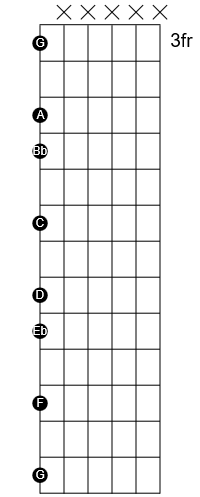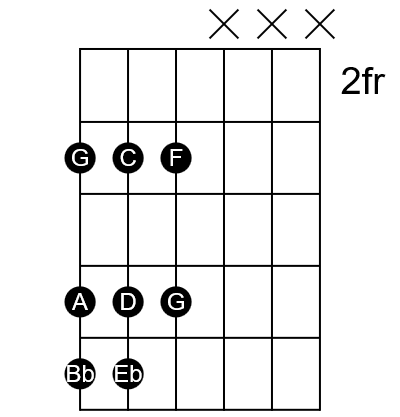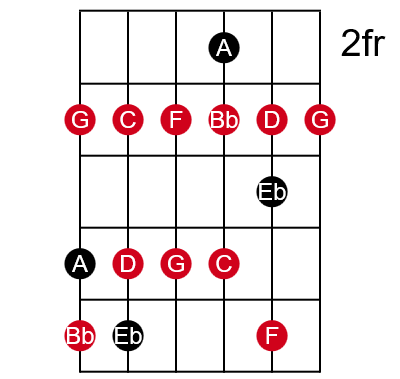
The minor scale brings a completely different dimension to music. It creates a moodier, perhaps sadder sound than the major scale.
What is the minor scale?
In music, the minor scale consists of seven notes of the chromatic scale. There are actually three main minor scales. The note degrees I, II, IIIb, IV, V, VIb, and VIIb make up the natural minor scale. The note degrees I, II, IIIb, IV, V, VIb, and VII make the harmonic minor scale. Finally, the note degrees I, II, IIIb, IV, V, VI, and VII make the melodic minor scale. In all three minor scale forms, the third scale degree is flat. Thus, a flat 3rd can be thought of as the main characteristic of any minor scale.
In this article, I’ll concentrate on the natural minor. From that scale you can change one note to construct the harmonic minor. Similarly, you can change two notes to make the melodic minor.
For details on the harmonic and melodic minor scales
Throughout this article, when I say “minor scale,” keep in mind that I’m referring specifically to the natural minor.
How to construct the natural minor scale in any key
First, make sure not to over complicate this issue. The minor scale contains no real mystery. Just like the major scale, it exists as a subset of the 12 chromatic notes in each octave. It also uses seven of the 12 chromatic notes.
In fact, you can look at the minor scale as simply a modification of the major scale, and it can be helpful to do so.
You’re not an expert at the major scale or the concept of scale degrees? Read
And, also just like the major scale, you can use a simple formula to find the notes of the minor scale in any key. The minor scale simply uses a different sequence of whole and half steps than the major scale does.
To make the natural minor scale, start on your chosen root note. Then use this recipe to find the rest of the scale notes:
- Whole step to the 2nd degree
- Half step to the 3rd degree (flat the 3rd of the major scale)
- Whole step to the 4th
- Whole step to the 5th
- Half step to the 6th (flat the 6th of the major scale)
- Whole step to the 7th (flat the 7th of the major scale)
- Whole step back to the root note an octave higher than where you started.
It’s easier to visualize graphically as:
W-H-W-W-H-W-W
Is a minor scale used often?
It’s probably safe to say composers most often use major keys in their works. But minor-key songs and compositions abound too. You can easily find minor-key songs (songs that use one of the minor scales) in virtually every genre of music.
Popular songs based in a minor key include:
- While my guitar gently weeps, by The Beatles
- Hurt, by Nine Inch Nails
- Take me to church, by Hozier
- Hello my name is Human, by Highly Suspect
- House of the Rising Sun, by The Animals
- Betty, by Taylor Swift
- Summertime, by the Gershwin Brothers and DuBose Hayward
- When Johnny comes marching home again, from the American Civil War
- California dreamin’, by The Mamas and the Papas
- Heart of gold, by Neil Young
And there are tons more in pretty much any genre. Of course, some of the greatest classical compositions of all time were written in minor keys as well. Among these are Beethoven’s “Moonlight Sonata” and Mozart’s “Molto Allegro”.
What characteristics define minor-key music?
Generally, everyone agrees that songs written in a minor key convey more a feeling of sadness and melancholy. Major key songs generally sound happier and more upbeat.
But minor-key songs can convey many other emotions as well. The minor scale can make music feel more contemplative and more introspective. Minor keys can build anxiety and potentially suspense into a song.
Songs of love and meaningful relationships can feel more poignant in a minor key. Major-key songs about these topics tend to feel joyous and happy go lucky.
Feelings of despair, depression, and hopelessness can all be stirred more easily by a minor-key composition than one in a major key.
Resentment and anger can be brought forth in minor keys. But so also can patience, forbearance, understanding, and quiet peacefulness.
So clearly minor keys have many different facets. These scales are extremely versatile.
As you learn more songs on the guitar, you’ll want to mix minor-key songs in with your favorite major-key numbers. This will give you refreshing variety in your repertoire. It’ll make your playing more interesting not only to you yourself, but also to anyone you play your music for.
How to play the natural minor scale on the guitar
Just as with the major scale, you have many options when it comes to playing the minor scale. When we talk about the minor pentatonic scale boxes, most people find the Box 1 pattern the easiest to learn and to play.
If you’re not familiar with the minor pentatonic scale, read
The minor pentatonic scale is really just a five-note subset of the natural minor, so let’s learn a pattern for the full scale based on Box 1 of the pentatonic version.

First play the scale on one string to find the notes
Let’s work out the notes of G Minor on the Low E string. We just need to follow the scale recipe. Of course we can follow this same procedure to find the notes in any key.
The root note G sits at fret 3. A whole step takes us to A at fret 5. A half step to Bb at fret 6. A whole step to C at fret 8. Whole to D at fret 10. Half to Eb at fret 11. Whole to F at fret 13. And finally another whole step takes us back to G at fret 15.
In this figure you can clearly see the pattern of whole and half steps that make up the minor scale.
Notice that the key of G Minor has two flat notes: Bb and Eb. But earlier I said that the natural minor had three flatted notes, so what’s going on?
Here you need to make sure you’re not confusing notes with scale degrees. It’s not these specific notes of the scale that get flatted, it’s the scale degrees.
Recall that the G major scale has all natural notes except for one sharp, the F#. When you flat the 3rd, 6th, and 7th scale degrees of the major scale in order to arrive at the minor, you transform the B (the 3rd degree of the major scale) to a Bb. You then flat the 6th degree, which takes you from E to Eb. And finally, you flat the 7th degree, and that turns the F# into an F natural.
Another major key has different notes, and so applying the same pattern to arrive at the minor version of that key flats the same scale degrees, but different notes.
Play one octave of the scale across three strings
Now that we know the notes of G Minor, let’s construct a scale box for one octave of the scale across multiple strings. You’ll begin to see how similar this box is to Box 1 of the minor pentatonic.

Start with the note G at fret 3 of the Low E string and fret that with your pointer.
Next, play A at fret 5 with your ring finger, and Bb at fret 6 with your pinky. There you have the first three degrees of the scale.
Next, move to the A string and repeat that exact pattern on the same frets with the same fingers. This gives you C at fret 3, D at fret 5, and Eb at fret 6. Those are the 4th, 5th, and 6th degrees of the scale.
Move to the D string. The first two notes repeat the pattern you’ve been using. So, you have the 7th degree, the F, at fret 3. And you return to the root one octave higher at fret 5.
Play the next octave on the remaining strings
So far the box has been very uniform. But the next octave is just slightly trickier.
For the next note, you have a decision to make because it doesn’t fit into the comfortable pattern you’ve been using. To get to the A, you either have to stretch your pinky up to fret 7 or move up to the G string and shift your hand so you can reach back to the A at fret 2.

I find the shift to the G string at this point more useful, so let’s do it that way. Next, slide your pointer up one fret to reach the Bb at fret 3. Play the C at fret 5 with your ring finger.
Shift up to the B string to play D at fret 3 with your pointer. Then play Eb with your middle finger on fret 4, and F at fret 6 with your pinky.
Finally, shift to the High E string to play the G at fret 3 and you’ve completed the second octave of the scale.
Hopefully you recognize the G minor pentatonic scale Box 1 in what you’ve just played. I’ve indicated those notes in red in the graphic.
You probably have already figured out that since there are five boxes of the minor pentatonic scale, there must be five boxes of the natural minor too. And it’s true. In fact, depending upon how you look at it, you might find as many as seven boxes. We’ll leave those for another discussion.
Conclusion
When we speak of the minor scale, we have to distinguish between three versions: the natural minor, the harmonic minor, and the melodic minor. Each of these are simply variations of the major scale. They all have a minor 3rd degree, so that is a general characteristic of minor scales.
A simple formula helps you identify the notes of the natural minor. You can apply this formula to any root note to find the notes of the natural minor in that key.
Many songs and compositions use minor keys, including many recognizable popular and classical songs. Minor key songs evoke many emotions, but generally feel sadder than major key songs.
To play the it on guitar, you can use a box that’s very similar to Box 1 of the minor pentatonic scale.
